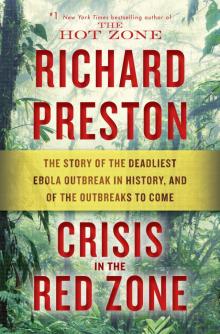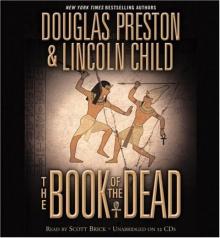- Home
- Richard Preston
Crisis in the Red Zone Page 2
Crisis in the Red Zone Read online
Page 2
Her rocketing stopped when her stomach was completely empty, and yet her vomiting continued. She started bringing up masses of a black, wet, curdlike material. The substance was recognizable in tropical countries as what is known as the black vomit. The black vomit is a sign of a fatal case of yellow fever. It is a hemorrhage from the lining of the stomach, and it consists of granules or curds of blackened blood which have been partly digested by stomach acid. Black vomit has a characteristic “wet coffee grounds” appearance, in which the granules are mixed with a dark, watery fluid that resembles weak black coffee. She may have come down with hiccups. The hiccups started for no apparent reason and wouldn’t stop. Unable to move from her bed, she became incontinent. At first the issuances of stool were whitened with mucus and streaked with blood. As she got sicker, her stool changed into a black liquid. The liquid, known as melena, is hemorrhage coming from the linings of the intestines. The membranes that form the linings of the intestines had died and were now undergoing bacterial decomposition. As the linings of the intestines decayed, blood began leaking from the necrotic tissue, filling the colon with blood. The blood became discolored and, eventually, when the colon was full, the blood was expelled. This was a form of profuse hemorrhage. A rash, consisting of red spots mixed with red bumps, spread around her torso. The red spots, called petechiae, were small hemorrhages occurring inside her skin. Some doctors refer to this type of hemorrhage as bleeding into one’s third space. The third space of the body is the soft tissue that lies between the skin and the muscles and fat. The third space can fill up with fluid or blood. Sister Beata’s facial expression changed, and her face settled into blank mask, seemingly without emotion, and with inflamed eyes.
YAMBUKU CATHOLIC MISSION
Sunday morning, September 19, 1976
It was still dark when Father Sango Germain, the curate of the Yambuku Catholic Mission, learned that his services were needed at Sister Beata’s hospital room. Father Germain was a thin man, in his sixties, with gray hair, glasses, and a long goatee. He gathered up a communion set and a bottle of holy oil, and he left the community house and walked along the path to the hospital. As dawn approached, the jungle surrounding the mission was giving off a wet smell and a piercing whine of cicadas. The palm swifts, small, noisy birds that slept in the palm trees, were beginning to stir, and the outlines of the palms were beginning to appear against the sky, their spidery fronds displaying a slightly menacing appearance.
He walked up the steps of the central pavilion and went to the nun’s room, where he found some sisters in attendance, who were praying and keeping vigil. We don’t know who among the sisters was there, although there is evidence that one of them was a certain Sister Genoveva. She was a fairly talkative person, less shy than some of the other nuns; she was Flemish, and her given name was Annie Ghysebrechts.
Father Germain placed his hands on Sister Beata’s forehead and prayed. Her fever had passed, and her skin felt merely warm to the touch. A nosebleed had left her nostrils blackened with caked blood. If she had been hiccuping, it had now stopped. She was conscious, but she seemed to be looking at something in the room that nobody else could see. Her eyes were bright red, her eyelids drooped slightly, and delicate pinpoints of blood stood along the rims of her eyelids, like strings of tiny rubies threaded among her eyelashes.
He removed the stopper from the bottle of oil and got some of it on his thumb, and anointed her forehead and hands with the sign of the cross. Soon he moved on to the viaticum, which is a person’s last holy communion. He held up the communion wafer.
This is the Lamb of God, who takes away the sins of the world.
She opened her mouth, or possibly he helped her get it open using his fingers. Her lips were dry to the touch. Small black crusts of dried blood had formed in the corners of her lips. Her tongue was bright red and wet, the color of arterial blood, and blood was leaking from her gums. He placed the wafer on her tongue.
Father Germain left no record of what happened next. About a month later, however, Sister Genoveva described the incident to at least two different investigating doctors. According to her, Sister Beata began crying as Father Germain administered the viaticum to her, and tears of blood came from her eyes and ran down her cheeks. The fluid that came from her eyes would have been a mixture of tears and blood. The blood was hemorrhage coming from the wet membranes of her eyelids. Sister Beata’s blood had lost its ability to clot, and so it mixed into her tears the way dye spreads into water, and the red liquid ran down her cheeks.
According to Sister Genoveva, when Father Germain saw the bloody tears running down Sister Beata’s face, he burst into tears, too. Weeping, he took his handkerchief out of his pocket and gently cleaned the nun’s face. Then he dabbed his bloodstained handkerchief into his own eyes, one and then the other, wiping the tears from his eyes, and he put his handkerchief back in his pocket. Father Germain had infected himself with Sister Beata’s bloody tears, and he would be dead thirteen days later. Sister Beata died at sunrise on that Sunday morning, just at the moment when the palm swifts were flying out of the palms and beginning a new day.
In the hours that followed Sister Beata’s death, the hospital’s Congolese nurses began quitting the hospital, and patients began leaving. There was a problem at the hospital. In the main wards, people were dying in beds soaked with blood and feces. There was something demonic about the illness. Their faces went blank, they hiccuped, they had nosebleeds, they became demented, and then, as the disease progressed, they expelled black blood from the anus. Then, for many of these patients, their fever went down and they started feeling better. This was a false dawn, which lasted for about forty-eight hours, and ended with a sudden collapse of blood pressure, known as a crash, followed by death. As the patients crashed and died, they had tremors and shaking at the point of death, and some went into a thrash of seizures at the end. Patients, terrified of the disease in the wards, walked out of the hospital, or if they couldn’t walk, their relatives carried them away on motorbikes or on hand-borne Congolese travel chairs. At four o’clock on the afternoon of Sister Beata’s death, a nun switched on the mission’s shortwave radio and began calling for help.
ROAD’S END
BUMBA ZONE
Four days after the death of Sister Beata, September 23, 1976
Jean-Jacques “J. J.” Muyembé-Tamfun, MD, PhD, vice-dean of the faculty of medicine at the National University of Zaire, sat in the backseat of a Land Rover that was jolting slowly through the jungle along a dirt road in northern Zaire. Night had arrived quickly, and the moon was down. The vehicle’s headlights revealed only the road running straight ahead into nothingness between parallel walls of huge trees entangled with vines. Occasional lurches of the vehicle threw J. J. Muyembé toward a doctor from the Congolese army named K. Omombo, who was sitting next to him. Muyembé wasn’t sure what the “K” in his colleague’s name stood for.
The driver steered the vehicle cautiously through small streams that crossed the road at low spots. As the annual rains grew stronger, roads in the Congo Basin went bad. What looked like a puddle in a road could turn out to be a vat of liquid clay that could engulf a Land Rover to the tops of its windows. For Zaire, this was a good road, Muyembé thought. They had been making an excellent ten miles an hour.
Jean-Jacques Muyembé was a virologist—a scientist who studies viruses—with a PhD from the University of Leuven in Belgium. At age thirty-one, he seemed to be at the start of a brilliant career. Muyembé was an energetic man of medium height, neither stout nor lean, with a round face and prominent cheeks. He had a soft voice and a down-to-earth manner, and he tended to squint when something amused him or when he was thinking hard. Muyembé was the head of the university’s biological laboratory.
Muyembé and Omombo were heading for Yambuku Catholic Mission, traveling on orders from Zaire’s minister of health, with an assignment to try to identify the mysterious disease at the m
ission and then to stop it, if they could. The doctors were given a ride to Bumba Zone in the cargo hold of a C-130 Hercules transport aircraft operated by the Zairian Air Force. The plane landed at a dirt airstrip in Bumba Ville, a market town on the north bank of the Congo River situated some eight hundred miles upstream from Kinshasa. In Bumba Ville, the doctors transferred several boxes of medical supplies to the Land Rover and set out immediately for Yambuku. They knew that night would catch them on the road, but they wanted to reach the mission as soon as possible.
Now, as the vehicle bumped and lurched its way through the darkness, J. J. Muyembé turned over in his mind what little he knew about the disease. The chief medical officer of Bumba Zone, Dr. Ngoy Mushola, had visited the Yambuku mission a few days earlier, where he had examined Sister Beata and a number of sick nurses and villagers. Dr. Ngoy had done his best to help the patients, though it didn’t take him long to realize that there wasn’t much of anything he could do for them. He took careful notes and filed a report. The disease was savage, with a “rapid evolution to death after a mean of three days,” he wrote. As he studied the signs and symptoms, Dr. Ngoy Mushola came to believe that he was seeing an unknown disease—a disease that had never been described by doctors and didn’t have a name.
J. J. Muyembé wasn’t so sure. In medicine, in science, the simplest explanation for something is usually the right one. Just on the basis of probability and common sense, Muyembé thought that the disease was unlikely to be something unknown. Much more likely, it was reasonably common and already had a name. He had no information about whether or not the disease at the mission was contagious.
* * *
—
At eight o’clock, the Land Rover came to a crossroads in a village called Yandongi, and the driver turned left. The road got worse, and entered a tract of deep lowland rain forest, as dark as pitch and inexpressibly wild. The forest wasn’t a wilderness. Tens of thousands of people lived in villages scattered in the area. The people were called the Budza, and they hunted and fished in the forest and grew crops of cassava and plantains. The Land Rover slowed to a crawl, and the enveloping forest seemed to become an invisible force pressing in on the vehicle from all sides, like water in an oceanic deep. Muyembé was feeling very thirsty. Eventually the road came out of the forest and began running through cassava fields and groves of oil palms. They had reached the Yambuku mission.
As soon as the Land Rover’s headlights washed over the community house, a group of nuns and priests hurried out of it. They were Belgians, and they were carrying a Coleman gas lantern and a pitcher of water. They greeted the doctors warmly and offered them cool water to drink. Muyembé drank deeply and asked for an immediate tour of the hospital.
The sisters were shy women, not ready for much talk, except for the nun named Sister Genoveva, who was less reserved than the others. We can imagine that she held the gas lantern and did much of the talking as the group walked toward the hospital. The group went up a set of steps into the main pavilion.
The building was quiet and dark. Past the entrance, there was an office on the right. They shone the lantern into the office, but there was nothing of interest to be seen. Past the office, the building divided into wings, which had in them open wards filled with rows of iron-frame beds. The beds were empty. The wards were deserted. The floors were filthy in some places, and sheets had been stripped off beds, revealing mattresses made of thin slabs of foam. Many of the foam mattresses appeared to be soaked with body fluids and blood.
This was an abandoned hospital, a shocking sight. J. J. Muyembé had never seen an abandoned hospital in Equatorial Africa. African hospitals were always busy places, crowded with patients and their families and filled with activity—crying babies, people milling around, nurses discussing things, smoke drifting, food vendors walking around offering food for sale. The Yambuku hospital had been treating six thousand to twelve thousand patients a month, but now it lay deserted. So far, Muyembé and Omombo hadn’t seen any person with the disease.
The nuns led Muyembé and Omombo along a footpath to a small building that stood in a patch of grass surrounded by undergrowth and palms. The building, made of brown bricks like the others, had frosted windows and a roof made of clay tiles. A concrete ramp led upward to a pair of wooden doors. They opened the doors and found themselves in the hospital’s operating theater—a one-room structure.
A modern operating table stood in the center of the room. A surgical lamp had been placed near the operating table. Scattered on the floor were strips of soiled bandage and blood-soaked surgical sponges. The operating room seemed to have been hastily abandoned after a surgery. The group moved on.
As they were going along a covered walkway, they began to hear high-pitched sounds coming out of a doorway. It seemed that the hospital wasn’t completely deserted after all. They went through the door into a dark ward, and their flashlights and the gas lantern revealed rows of cribs and small beds. This was the children’s ward. The sounds were coming from a crib.
Muyembé bent over the crib and saw an infant boy writhing in agony. He couldn’t tell what was wrong with the baby. What had happened to the child’s parents? Did the baby have the disease? There didn’t seem to be anything Muyembé and Omombo could do to help the child. About five minutes after they found the baby, it stopped breathing and gave up its life.
The group visited the maternity ward, where Sister Beata had worked. At least three women had delivered dead or extremely sick babies in the ward. The infants had come out in pools of blood, and the mothers and infants had all died. The ward appeared to have been abandoned suddenly. A long cotton skirt, printed with a bold black-and-red pattern, had been placed, neatly folded, on a table by the wall. A crumpled surgical gown had been flung across the table by the folded skirt, as if a nurse had taken off her gown suddenly and left the room. The surface of the metal birthing table was smeared with dried blood. There were blood-soaked surgical tampons scattered on the floor. Elsewhere in the birthing room the doctors found basins of brown standing water. The water in the bowls had been clean and hot when childbirths were happening in the ward, and the maternity nurses had used the water to make hot compresses. The blood-tainted water had been sitting in the bowls for days, and had gone putrid in the heat.
LIFE FORM
YAMBUKU
9 p.m., September 23, 1976
After touring the hospital, Muyembé and Omombo ate dinner in the community house with the fathers and sisters. The meal that night was fufu, plantains, and rice topped with a green sauce made from pounded cassava leaves. Muyembé really liked the dinner. It was the best country food—simple, vegetarian, delicious, good for the body.
The religious people were in a state of anxiety over the deaths of patients and nurses, and they ate quietly. The Father Superior of the mission, Augustin Sleghers, may have been sweating heavily, his eating utensils possibly shaking in his hands. He seemed to be coming down with malaria. Sister Genoveva, the talkative nun, appeared to be in good health. Alcohol was forbidden at the mission, but Father Léon Claes, a sturdy, convivial priest they called Father Léo, occasionally liked to serve to his fellow missionaries a special cocktail of his own making, which he mixed from vermouth, lemons, and raw banana alcohol. Father Léo seemed to be holding steady, possibly with the help of one of his cocktails. The curate of the mission, Father Sango Germain, a thin, older man with a bushy goatee, was subdued at the dinner table. He may have been grieving or traumatized, because he had given the last rites to Sister Beata only four days earlier. Also present at the dinner table was a nun named Sister Myriam. She was a thin, extremely quiet Belgian woman, of middle years, with a narrow face and a long, delicate nose. Sister Myriam may have been suffering from a creeping sense of malaise, though if she was feeling unwell she didn’t mention it at the table.
As he ate cassava leaves and made a bit of conversation with the clerical people, Muyembé thought abo
ut what he’d just seen in the empty hospital. He faced two simple questions: What is it? How can it be stopped?
He still hadn’t examined any patients with the disease. How could he and Dr. Omombo deal with it if they didn’t know what it was? And how could they know what it was if they hadn’t seen any people with the disease? As for the dying baby in the children’s ward, a baby in rural Africa could die of almost anything. So far, the disease was only a rumor or a mirage, a horripilant shadow that had passed through the hospital, killing patients, and had now gone elsewhere, at least for the moment. Muyembé, as a virologist, had to consider the possibility that this could be a virus. He respected viruses for their power over human lives.
* * *
—
A virus particle is a very small capsule made of proteins locked together in a mathematical pattern. The pattern of the interlocking proteins in a virus is far more complicated than a snowflake. The protein capsule is sometimes wrapped in an oily membrane. Inside the capsule there is a small amount of DNA or RNA, the molecules that contain the genetic code of the virus. The genetic code is the virus’s operating system, or wetware, the complete set of instructions for the virus to make copies of itself. Unlike a snowflake or any other kind of crystal, a virus is able to re-create its form. It would be as if a single snowflake started copying itself as it falls, and those copies of the snowflake copy themselves, creating ever-growing numbers of identical copies of the first snowflake, until the air is filled with falling snow, and each flake is a perfect replica of the first flake.
Many virologists feel that viruses are not truly living things. At the same time, viruses are obviously not dead. Virologists like to describe them as life forms. The term is a contradiction: How can something be a form of life that isn’t alive? Viruses carry on their existence in a misty borderland that lies between life and death, a gray zone where the things we encounter are neither provably alive nor certainly dead.

 The Demon in the Freezer
The Demon in the Freezer Panic in Level 4: Cannibals, Killer Viruses, and Other Journeys to the Edge of Science
Panic in Level 4: Cannibals, Killer Viruses, and Other Journeys to the Edge of Science The Cobra Event
The Cobra Event The Hot Zone
The Hot Zone Crisis in the Red Zone
Crisis in the Red Zone First Light: The Search for the Edge of the Universe
First Light: The Search for the Edge of the Universe The Book of the Dead
The Book of the Dead Panic in Level 4
Panic in Level 4